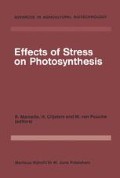Abstract
Primary leaf plastid development and photosynthetic activity in Echinochloa (barnyard grass) were monitored during a 5 day time course of germination and growth in a nitrogen atmosphere. After 8 hours imbibition in the light but without oxygen, the proplastids were spheroidal and contained a few rudimentary stromal thylakoids. However, during the next 126 hours of anaerobiosis, plastid size and stromal thylakoid numbers increased markedly. Under anaerobiosis plastid morphology was also characterized by the development of prolamellar bodies, previously reported only in etiolated tissues, while changes in starch grains and plastoglobuli indicated carbohydrate and lipid metabolism, respectively. Upon exposure to air the arrested development of chloroplasts was reversed. Compared to etioplasts when exposed to light, however, there was a lag for the first 18 hours before the plastids developed rapidly into typical, C4 mesophyll and bundle sheath chloroplasts.
Chlorophyll synthesis and development of photosynthetic capability began slowly when seedlings were transferred from N2 to air. Whereas etiolated seedlings exhibited net CO2 fixation after approximately 12 hours after exposure to light, anaerobically-grown seedlings did not show a positive CO2 gas exchange until about 55 hours after transfer from N2 (light) to air (light). The kinetics for CO2 uptake more closely resemble those of RuBP carboxylase, the C3 cycle enzyme, than they do PEP carboxylase. Upon transfer to air (light), “anaerobic” shoots had about 60% of their ultimate PEPcase, but less than 20% of their RuBPcase activity. The predominance of PEPcase over RuBPcase in shoots grown without oxygen also occurs in rice, a C3 plant. Thus, when rice and oryzicola were transferred to air after germination in an N2 (light) environment, the early-labeled 14CO2 fixation products in both grasses were predominantly C4 acids. Based on 14CO2 labeled intermediates, however, oryzicola appeared capable of developing carbon cycle capability faster than rice. Such a head start may, in part, explain oryzicola’s ability to emerge and outcompete rice in field situations.
Access this chapter
Tax calculation will be finalised at checkout
Purchases are for personal use only
Preview
Unable to display preview. Download preview PDF.
References
Arnon, D. I. 1949. Copper enzymes in isolated chloroplasts, polyphenol oxidase in Beta vulgaris. Plant Physiol. 24:1–15.
Kennedy, R. A., Barrett, S. C. H., Vander Zee, D., Rumpho, M. E. 1980. Germination and seedling growth under anaerobic conditions in Echinochloa crus-galli (barnyard grass). Plant, Cell and Environment 3:243–248.
Kennedy, R. A. Laetsch, W. M. 1973. Relationship between leaf development, carboxylase enzyme activities and photorespiration in the Copiant Portulaca oleracea L. Planta 128:149–154.
Vander Zee, D., Kennedy, R. A. 1982. Plastid development in seedlings of Echinochloa crus-galli under anoxic germination conditions. Planta 155:1–7.
Williams, L. E., Kennedy, R. A. 1978. Photosynthetic carbon metabolism during leaf ontogeny in Zea mays L.: Enzyme studies. Planta 142:269–274.
Author information
Authors and Affiliations
Editor information
Editors and Affiliations
Rights and permissions
Copyright information
© 1983 Martinus Nijhoff/Dr W. Junk Publishers, The Hague
About this chapter
Cite this chapter
Kennedy, R.A., Vander Zee, D., Bozarth, C.S. (1983). Chloroplast Development and Photosynthesis in Echinochloa (Barnyard Grass) and Rice: O2 and Flooding Stress. In: Marcelle, R., Clijsters, H., van Poucke, M. (eds) Effects of Stress on Photosynthesis. Advances in Agricultural Biotechnology, vol 3. Springer, Dordrecht. https://doi.org/10.1007/978-94-009-6813-4_37
Download citation
DOI: https://doi.org/10.1007/978-94-009-6813-4_37
Publisher Name: Springer, Dordrecht
Print ISBN: 978-94-009-6815-8
Online ISBN: 978-94-009-6813-4
eBook Packages: Springer Book Archive

